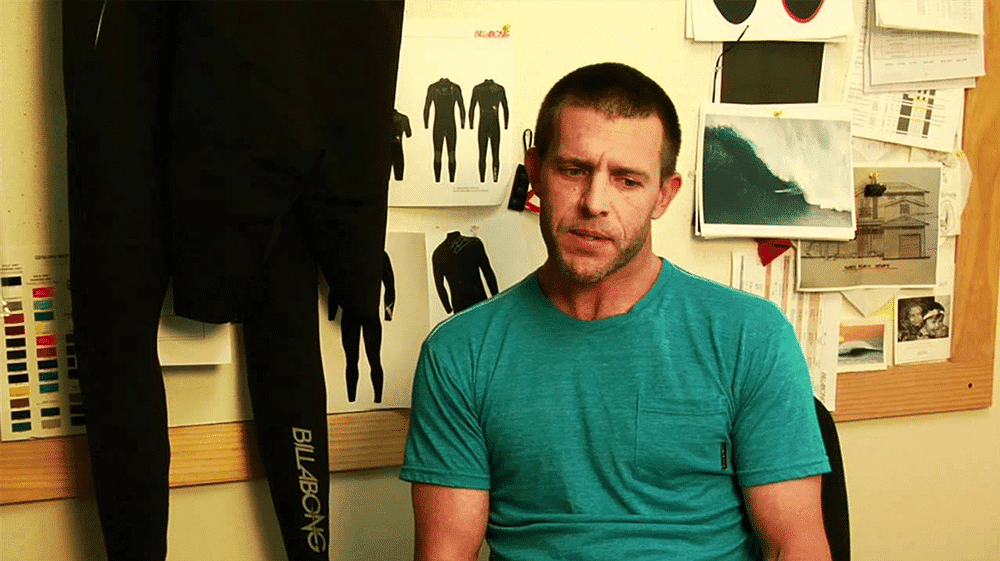
Surfing Gladiators Embrace Patented Inflatable Surf Vest
In Life & Death Situations, Marine Safety Device Can Save Lives

Sometimes when death stares us in the face, we not only discover untapped reservoirs of courage but the keys to a new invention that will save countless lives in the future.
Shane Dorian experienced these dual thoughts when he fell off a giant wave at Mavericks, California, one of the most challenging surf spots on the planet. What followed was several minutes of terrifying turbulence as he was pushed 25 feet below the surface to the ocean floor. As he struggled to make it back to the surface, two more giant waves crashed down, keeping him submerged. It would be life-changing experience and alter the course of big wave surfing forever.
Panic At Mavericks
Dorian was no mere mortal: At the time he was part of an elite, sponsored group of big wave gladiators and a former top 10 surfer on the ASP world tour.
Yet even with his experience traveling the world surfing megalithic waves, underwater training, and countless wipe outs in big surf he knew he was close to death.
With his lungs burning and panic flooding his nervous system he fought his way back up and broke through the chaotic white water to gasp lifesaving air. Numb with weakness and exhaustion, a rescue jet ski team motored him back to shore where he went into a bout of deep reflection.
As he replayed the suffocating experience over and over in his mind, a thought coalesced: Peak physical condition, mental preparation and willpower are not always enough to keep you alive in big waves.
The Death Of Mark Foo


Several years earlier another famous big wave surf, Mark Foo, had died at this exact same spot.
Disturbingly, the waves had been smaller that day. No, Dorian thought, surfers needed a simple, fast, technological advantage like pulling a rip cord on a parachute or an inflatable vest on airplane, in order to survive these wipe outs.
Minutes later he concluded the answer lay in modifying the wetsuit that surfers use to keep warm during surf sessions. He visualized a game-changing personal flotation device built into the fabric of suit that would rapidly inflate when a cord was pulled, elegantly ascending the surfer to the surface with minimal effort.
Watermen Inventors

If this story sounds familiar, it should. Troy Faletra, a long-time surfer and fisherman, who I proudly count as a client and friend of mine, experienced a similar life and death moment on the ocean when his boat sank several miles from shore.
He endured a grueling 10 mile swim back to land. For ten hours he battled the currents off Fort Lauderdale before making it to shore.
Like Dorian, he lay exhausted on the sand, envisaging how a new invention could transform marine safety.
His idea for an inflatable, throwable device that inflates in seconds – no bigger than a square cushion – would eventually win Coast Guard Approval, an award at the Miami Boat Show and five patents in over 40 countries.

The Survivors
Both these watermen had a deep connection to the ocean, respecting both its beauty and destructive power. Linked through their love of surfing, they understood the power of simple solutions that needed to work quickly and required little thought.
Both were extremely well conditioned by years of interaction with the ocean, giving them an edge when it came to survival. Yet both knew they had been extremely lucky to survive and wanted all people to have an advantage when it came to survival at sea.
Rethinking The Wetsuit
As Dorian stood up on the beach that day, he decided he needed to contact the lead wetsuit designer, Hub Hubbard, at his sponsor, Billabong. He outlined a radical adaption to the traditional wetsuit: An air bladder built into the vest that would inflate with a single pull of a reachable cord.
He know this approach would help all big wave surfers giving them an edge in wipeouts. Some of these surfers had fallen off waves approaching 50-60 feet in height, enough to crush to the human body in seconds or keep them underwater for minutes at a time.




Engineering An Inflatable Surf Vest
Hubbard was initially skeptical the idea could be implemented but understood the gravity of Dorian’s request. It was a transformational idea that deserved his attention and he was up for the challenge.
Working with Mustang Survival, a leader in inflatable technology, sketches and prototypes were developed in a remarkably short time frame.
“In fact, within two hours I think we had a working prototype,” recalled Hubbard.
After some refinement, Hubbard sent a rudimentary kit by mail to Dorian to test drive himself in the Big Blue.
Dorian examined the kit with excitement, which included a bayonet CO2 cylinder. He rigged it up in his suit and swam out on a calm day in Holualoa, Hawaii. Diving deep he hovered for a second, before pulling the cord.

Idea Ascending
“As soon as it started inflating, I knew for sure this would change the game of surfing,” said Dorian. The inflated bladder gently pulled him to the surface in a relaxed, controlled manner confirming the elegance and functionality of this groundbreaking marine device.
A key decision made by Dorian and the Billabong team was to position the air bladder at the back of the suit, rather than the front. This in some ways may seem counter-intuitive to the general public since it suggests it would push the surfer’s face into the water upon breaking the surface.
“We realized the surfer still had to be able to paddle on his surfboard once he surfaced. Having the bladder at the back allowed them to do this with their face up,” said Dorian. After additional adjustments to the suit which operated in a similar manner to parachute when pulled, Dorian was ready for the real litmus test: Giant waves.
The Cortez Bank

The opportunity materialized with a trip to the Cortez Bank situated 100 miles off the California shore.
This is one of the loneliest and remote giant surf spots on the planet, existing on a submerged shoal in the middle of the ocean.
It was only ridden for the first time in 1990 and demands a huge degree of courage and skill on the part of the surfer to ride and survive.
“I remember falling off a huge wave and being pushed down super far. I pulled the cord and went from nearly panicking to being totally relaxed. I did not swim. I just let the thing pull me up,” said Dorian.
The device saved him again when he wiped out another giant surf later that year, Jaws. He fell off a 57-foot wave but survived the hideous wipe out by pulling the rip cord on the inflatable device.
Birth Of The V1
Dorian and Billabong christened the device, V1, offering it as a limited release to select group of big wave surfers. The “V” stands for vertical ascent indicating a positive attitude, or one foot above sea level.
In this respect, his commercial approach to the personal marine safety device differed from that of Troy Faletra who invented ThrowRaft®. Troy wanted his throwable inflatable device to reach a worldwide audience of boating and watercraft enthusiasts who may one day find themselves at the mercy of the sea.
Yet both surfing inventors understood the value and necessary of securing patents for the marine devices.
In Troy’s case, he had a long and hard journey to commercial success but stated that intellectual property was a foundational cornerstone of unlocking financial and business freedom.

Rising Up To The Challenge

“In the darkest moment of my life, I had lost my dad and my wife, John Rizvi said to me: ” You get one damn go-around in this life. Make it Count.” He told me never to give up and convinced me that my ThowRaft® device could become a successful product once patented. After a lot of hard work, I then got U.S. Coast Guard Approval which has led to huge growth,” said Troy.
TROY FALETRA // Inventor, Entrepreneur & Surfer
By the time you read this, ThrowRaft® will have been purchased by over 1000 people and businesses, with these numbers growing daily.
Today Troy is an expert in CO2 canisters, self-inflation mechanics, and visibility colors for search and rescue.
His love for perfecting a survival inflatable device has resulted in a retail product that weighs just three pounds and takes up five times less space than a traditional cushion.
Patenting The V1 Inflatable Surf Vest

In Dorian’s case, he secured a patent for the inflatable wet suit along with John Dave Hubbard, his collaborator at Billabong. While his device is aimed at surfers, the patent does itself cover novel use by a variety of water enthusiasts who may benefit from its use during emergency situations, requiring life-saving buoyancy and flotation aids.
V1 Patent
Abstract
The inflatable wetsuit will preferably include a torso section having a back pocket and a bladder assembly having an inflatable bladder bag and an inflator valve adapted for operative connection with a compressed gas canister positioned within the back pocket. A rip cord has one of its ends connected to the inflator valve and extends over a shoulder region of the torso section so that the other end thereof is positioned adjacent a front portion of the torso section. A canister pouch within the back pocket of the torso section is provided for receiving the gas canister therein. The canister pouch includes a front wall attached to the torso section alongside and bottom edges.
“Novel” & “Non-Obvious”
These two words above, “novel” and “non-obvious” are crucial elements of any successfully patent application with the United States Patent Office (USPTO). While personal flotation devices or “life vests” were in some use when Dorian came up with his idea, several existing proposals to integrate that technology with wetsuits were at various degrees of consideration and implementation.
Thus, the V1 patent application argued that its approach was indeed novel and non-obvious since it made specific improvements that went beyond other patent applications inside the USPTO database.
This is vital point to understand and internalize: Inventors can still file a successful patent even if similar – but not identical – commercial inventions exist.

In many instances, an inventor may take a well-known idea and blend it together with another unrelated concept giving it a novel and non-obvious use.
A recent example of this can be found with Valerie Carbone, a client of mine who patented and commercialized EyeBandz®, which unites common reading glasses with headbands.
Patent Pending
When the United States Patent Office finally awarded the patent to Dorian and Hubbard, it cited over 24 other patents that overlapped to some degree with the V1.
Some of these ideas and commercial inventions included life preservers, life-saving suits, snorkeling vests, expedition jackets, fashionable emergency flotation aids, avalanche survival kits, and rescue harnesses.

Avalanche Survival Kit: Patent US20070056500A1
It also shows the possibilities open to inventors to explore parallel industries like skiing where the device may find potential use cases and associated intellectual property protection.
Most importantly, it reveals the complexity of filing a marine patent with the USPTO. There is an overwhelming database of prior art and patents that need to be carefully examined to determine whether your idea can be protected by intellectual property.
It’s a complex, time consuming exercise best performed by a specialized patent attorney.
This is why inventors like Troy Faletra put their faith in specialist patent attorneys: Commercial success often hinges on intellectual property protection to foster industry credibility and open doors with large institutional buyers or government arms like the Coastguard.
THE $100 MILLION DOLLAR INVENTOR
In fact, another one of my medical device inventor clients Alex Gomez, stated that the $100 million sale of his healthcare startup to a large conglomerate was largely possible due to the defensible intellectual property protection underlying the commercial operations. Make sure your idea is protected fully under patent law!

Attempting to file yourself (or using non-specialist patent lawyers) generally leads to a filing rejection by the USPTO.
Most small entrepreneurs like Dorian, Faletra, and Gomez above, cannot afford to begin a commercialization journey without a successful patent in place.
Commercializing Marine Inventions
Both Dorian and Faletra can lay claim to revolutionizing their respective industries. The V1 has rapidly transformed big wave surfing and general boating respectively into safer, less dangerous activities.
However, Faletra has one commercial, regulatory, and branding advantage that Dorian’s patented surfing device cannot match:
Commercial
Advantage
It’s the only inflatable throwable device Type IV on the market approved by the U.S. Coast Guard. This is an astounding endorsement which owes some of its success to the underlying patent protection which Troy proudly displays on his ThrowRaft® website.
While Dorian’s device requires the surfer to pull a cord to inflate, the ThrowRaft® auto-inflates when submerged underwater. It is finding broad use the world over with the general public who engage in watercraft activities.
The V1 takes an entirely different approach: Its limited release to a cadre of well-known big wave surfers is partly due to the context of surfing big waves.
The device requires some basic training or acclimation to use effectively which makes it more challenging to market to the general public, which includes amateur big wave enthusiasts.
Billabong stated early on that it had no plans to sell the V1 to the broader market, intent on focusing its energy on professional big wave surfers who form a tiny elite in the surfing world.

An Invention To Save Friends’ Lives
“I’ve had three or four really close friends die surfing in really big waves and every single one of them drowned. And now that it’s done, now that the thing is ready to go, I’m excited to give it to all my friends who are the very best big wave surfers in the world.”
SHANE DORIAN // Surfer & Inventor
Another subtle reason for the V1 approach could relate to the general philosophy of risk-taking in world surfing.
By releasing the wetsuit safety device to the masses, it could embolden surfers to take bigger risks in giant waves that previously would not have been considered.
This would lead to more crowded lineups and a dangerous cocktail of amateur surfers who are not physically or mentally prepared for a life-threatening situation in which the V1 may malfunction.
Creating a false sense of security has no place in big waves with one well-known surfer concluding that, “mediocre preparation for 40-foot waves is not going to be bolstered by spare air or an inflatable wetsuit.
The Competition

As can be expected, rival surf companies have followed suite with their own inflatable vest devices. This includes Quicksilver and Patagonia, the latter of which filed a patent for its Watersports Inflation Vest and markets its product as the PSI or Personal Surf Inflation Vest.
It’s patent states that while some attempts have been made to commercialize inflatable vests, including Dorian’s version which utilizes a pressurized air canister and rip cord, they fall short in offering simple, quick deflation and inflation methods without returning to land after use.
“Therefore, there exists a need in the art for a selectively inflatable and deflatable garment, such as a vest, for deployment in deep water such as surf or other potentially dangerous conditions,” stated Patagonia’s patent filing with the USPTO.
Patagonia also recently decided that limiting the PSI to the elite big wave surfing community was restricting its brand and approach. It now has a pathway for amateur big wave surfers to purchase the vest after a light vetting process. This includes some formal big-wave safety training and completing an approved, certified course.
The Next Generation
Shane Dorian’s V1 device triggered a Tsunami of innovation in the surfing community and wetsuit arena. In the years that followed his invention, several innovative approaches have been implemented commercially by other surf companies.
This includes a new auto-inflation device under development by Oceanic Safety Systems.
The inventor, Dr. Terry Maas, had originally targeted the device at the free diver community and military sector but saw an opportunity to save surfers who are knocked unconscious after hitting the reef (or their board) during a wipeout.

Dr Terry Maas: “Our Inflatable Surf Vest could trigger when a big-wave surfer is thrown free and submerged and they had set their timer of 40 seconds, if they were not pulled out of the water by that time, the vest inflates. Bethany Hamilton, seen above, road her biggest wave to date using a vest equipped with our Gen-3 inflator.”
Many believe that Mark Foo – mentioned earlier in the article – may have been knocked unconscious by his board at Maverick’s, ultimately costing him his life by drowning.
Dr. Maas believes that this tragedy could have been averted through an inflation device that fires automatically after a maximum time period underwater. An alternative approach triggers the device once the surfer reaches a certain depth.
The addition of these automation triggers illustrates how an existing idea may be extended and made more novel and non-obvious.
A good patent attorney will consider all these variations when crafting bulletproof patent protection.
The Next Wave

“Only a surfer knows the feeling,” is a well-known quote that board riders often use to describe their sport (or art). When applied to a wipeout, big wave surfers will attest to the fear and panic that courses through the body as attempts are made to reach the surface.
For a few humans, staring death in the face unlocks a creative channel in which giant inventions are born in the form of small devices or technology.
Such is the case for Shane Dorian who has made his gladiatorial sport a safer place for his friends and contemporaries through the patented VI inflatable surfing vest.
He mirrors the journey of Troy Faletra and ThrowRaft, who transformed the pastime of boating forever with his throwable personal flotation device. Both inventors and entrepreneurs are connected through their love of the ocean and surfing.
Both continue to explore new commercial pathways for their marine inventions confidently secured through bulletproof patent protection.
The next time you see a surfer fall on a big wave or read about a boat sinking far offshore, there is a good chance that all involved survived through the two innovative products described above.
Inventor Inspiration

Playing Chicken: Tesla Goes After Small Chicken Business for Trademark Infringement
Large companies and brands are going to greater lengths than ever before to expand their holdings and protect the ones they’ve already locked down. From

The Emperor Has No–Shoes? Trump’s New Sneakers Could Get Him In More Legal Trouble
Donald Trump made waves at Sneaker Con in Philadelphia this week by unveiling his latest business venture: sneakers. The gold-uppered, red-soled shoes, emblazoned with a

“Holdovers” or Leftovers? Plagiarism Accusation Rocks Oscars
On the eve of Hollywood’s biggest evening, veteran screenwriter Simon Stephenson went public with a shocking accusation: the script for “The Holdovers,”the Paul Giamatti vehicle

Toy Company To Police Department: Lego My Face!
On March 19th, 2024, Lego, the building toy giant, reached out to the police department of Murietta, California with an unusual complaint: that the department’s

Are Donald Trump’s Red Soled Sneakers A Lawsuit In The Making? – Wbz Radio News
0:00 President Donald Trump, 0:02 who, as you know, lost the case in New York and now reportedly owes the state of New York $355

Daryl Hall Tells John Oates “No Can Do,” Sue’s to Block IP Sale
Legendary pop/soul/rock pioneers Hall & Oates have had several groups’ worth of ups and downs as they evolved from a scrappy Philadelphia startup band to

JOIN MY FACEBOOK GROUP
A Community for Inventors Seeking Strategies & Techniques for Patenting & Bringing Ideas to Market. It’s growing daily! Hope to see you inside!




